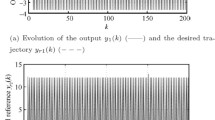Abstract
In this paper, a multivariable direct adaptive controller using multiple models without minimum phase assumption is presented to improve the transient response when the parameters of the system jump abruptly. The controller is composed of multiple fixed controller models, a free-running adaptive controller model and a re-initialized adaptive controller model. The fixed controller models are derived from the corresponding fixed system models directly. The adaptive controller models adopt the direct adaptive algorithm to reduce the design calculation. At every instant, the optimal controller is chosen out according to the switching index. The interaction of the system is viewed as the measured disturbance which is eliminated by the choice of the weighing polynomial matrix. The global convergence is obtained. Finally, several simulation examples in a wind tunnel experiment are given to show both effectiveness and practicality of the proposed method. The significance of the proposed method is that it is applicable to a non-minimum phase system, adopting direct adaptive algorithm to overcome the singularity problem during the matrix calculation and realizing decoupling control for a multivariable system.
Similar content being viewed by others
References
Astrom K J, Wittenmark B. On self-tuning regulators. Automatica, 1973, 9(2): 195–199
Goodwin G C, Hill D J, Palaniswami M. A perspective on convergence of adaptive control algorithms. Automatica, 1984, 20(5): 519–531
Lainiotis D G. Partitioning a unifying framework for adaptive system. I: Estimation. Proc IEEE, 1976, 64(8): 1126–1143
Athans M, Castanon D, Dunn K, et al. The stochastic control of the F-8C aircraft using a multiple model adaptive control (MMAC) method part I: Equilibrium flight. IEEE Trans Autom Control, 1977, 22(5): 768–780
Fu M Y, Barmish B R. Adaptive stabilization of linear systems via switching control. IEEE Trans Autom Control, 1986, 31(12): 1097–1103
Middleton R H, Goodwin G C, Hilland D J, et al. Design issues in adptive control. IEEE Trans Autom Control, 1988, 33(1): 50–58
Narendra K S, Balakrishnan J. Improving transient response of adaptive control systems using multiple models and switching. IEEE Trans Autom Control, 1994, 39(9): 1861–1866
Narendra K S, Balakrishnan J, Ciliz M K. Adaptation and learning using multiple models, switching and tuning. IEEE Control Syst Mag, 1995, 15(3): 37–51
Narendra K S, Balakrishnan J. Adaptive control using multiple models. IEEE Trans Autom Control, 1997, 42(2): 171–187
Narendra K S, Xiang C. Adaptive control of discrete-time systems using multiple models. IEEE Trans Autom Control, 2000, 45(9): 1669–1686
Wittenmark B, Astrom K J. Practical issues in the implementation of self-tuning control. Automatica, 1984, 20(5): 595–605
Wang X, Li S Y, Cai W J, et al. Multi-model direct adaptive decoupling control with application to the wind tunnel. ISA Trans, 2005, 44(1): 131–143
Clark D W. Self-tuning control of nonminimum-phase systems. Automatica, 1984, 20(3): 501–517
Goodwin G C, Ramadge P J, Caines P E. Discrete-time multivariable adaptive control. IEEE Trans Autom Control, 1980, 25(3): 449–456
Zhang G J, Chai T Y, Shao C. A synthetic approach for control of intermittent wind tunnel. In: Proceedings of the American Control Conference, New Mexico, 1997. 203–207
Yu W, Zhang G J. Modelling and controller design for 2.4 m injector powered transonic wind tunnel. In: Proceedings of the American Control Conference, New Mexico, 1997. 1544–1545
Nelson D M. Wind tunnel computer control system and instrumentation. In: The 35th International Instrumentation Symposium, Orlando. 1989. 87–101
Pels A F. Closed-loop Mach number control in a transonic wind tunnel. Journal A, 1989, 30(1): 25–32
Soeterboek R A M, Pels A F, Verbruggen H B, et al. A predictive controller for the Mach number in a transonic wind tunnel. IEEE Control Syst Mag, 1991, 11(1): 63–72
Motter M A, Principe J C. Neural control of the NASA Langley 16-foot transonic tunnel. In: Proceedings of the American Control Conference, New Mexico, 1997. 662–663
CARDC. Measurement and Control System Design in High and Low Speed Wind Tunnel (in Chinese). Beijing: National Defence Industry Press, 2002
Author information
Authors and Affiliations
Corresponding author
Additional information
Supported by the National Natural Science Foundation of China (Grant Nos. 60504010, 60864004), the National High-Tech Research and Development Program of China (Grant No. 2008AA04Z129), the Key Project of Chinese Ministry of Education (Grant No. 208071), and the Natural Science Foundation of Jiangxi Province (Grant No. 0611006)
Rights and permissions
About this article
Cite this article
Wang, X., Yang, H. & Zheng, Y. Multivariable direct adaptive decoupling controller using multiple models and a case study. Sci. China Ser. F-Inf. Sci. 52, 1165–1176 (2009). https://doi.org/10.1007/s11432-009-0128-3
Received:
Accepted:
Published:
Issue Date:
DOI: https://doi.org/10.1007/s11432-009-0128-3




